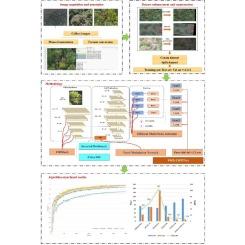PWD-lightweight and feature fusion network for multi-stage joint detection of pine wilt disease
IF 8.9
1区 农林科学
Q1 AGRICULTURE, MULTIDISCIPLINARY
引用次数: 0
Abstract
Pine Wilt Disease (PWD) has caused irreversible damage to the health of pine forests around the world. Accurate detection and identification is the prerequisite for taking measures to prevent the spread of PWD. To tackle this challenge, this study presents PWD-Lightweight and Feature Fusion Network (PWD-LWFFNet), a specially designed object detection model for detecting PWD in pine trees. PWD-LWFFNet uses lightweight EIBNet as its backbone network, which is mainly implemented by the EIB module for lightweighting. The EIB module utilizes the inverted bottleneck module and incorporates Extra Depthwise convolution (DW) to minimize the number of parameters while ensuring computational efficiency. In the neck network, PAFPN-4Net was designed as a multi-scale feature fusion network and an FMN module was introduced. The FMN module merges the input features with the global information through its ‘aggregation’ and ‘modulation’ components. This setup allows the network to dynamically focus its attention on the minute disease details in the early stages of pine tree infection. Four detection heads are designed and integrated with the Enhanced Multi-scale Attention (EMA) mechanism to capture fine-grained features. Finally, PIoUv2 is selected as the loss function to guide anchor boxes along the optimal path for regression. Comprehensive experiments demonstrate that PWD-LWFFNet exhibits excellent performance in detecting PWD, which the mean Average Precision (mAP) is 94.1%. It particularly excels in detecting small, early-stage targets compared to other mainstream models, with an Average Precision (AP) of 83.4%. The detection accuracies for the middle, late, and tree mortality stages reach 97.3%, 98.4%, and 97.2% respectively. When compared with existing mainstream models, PWD-LWFFNet demonstrates state-of-the-art performance. Experiments conducted on the PWD dataset established in this paper show that PWD-LWFFNet maintains good performance even in environments with background noise, validating the effectiveness of the model in early disease detection and management in pine forests. Its lightweight design provides a guarantee for practical application deployment.

面向松材萎蔫病多阶段联合检测的pwd -轻量级特征融合网络
松材萎蔫病(PWD)对全球松林健康造成了不可逆转的损害。准确的检测和识别是采取措施防止PWD蔓延的前提。为了解决这一挑战,本研究提出了PWD-轻量级和特征融合网络(PWD- lwffnet),这是一种专门设计的用于检测松树PWD的目标检测模型。PWD-LWFFNet采用轻量级EIBNet作为骨干网,主要由EIB模块实现轻量化。EIB模块采用了倒瓶颈模块,并结合了额外深度卷积(Extra deep - wise convolution, DW),在保证计算效率的同时最小化了参数的数量。在颈部网络中,将PAFPN-4Net设计为多尺度特征融合网络,并引入FMN模块。FMN模块通过其“聚合”和“调制”组件将输入特征与全局信息合并。这种设置允许网络动态地将注意力集中在松树感染早期的微小疾病细节上。设计了四个检测头,并与增强型多尺度注意(EMA)机制集成,以捕获细粒度特征。最后选择PIoUv2作为损失函数,引导锚盒沿最优路径进行回归。综合实验表明,PWD- lwffnet在检测PWD方面表现出优异的性能,平均平均精度(mAP)达到94.1%。与其他主流模型相比,它在检测早期小目标方面表现特别出色,平均精度(AP)为83.4%。中期、晚期和树木死亡阶段的检测准确率分别为97.3%、98.4%和97.2%。与现有的主流模型相比,PWD-LWFFNet具有最先进的性能。在本文建立的PWD数据集上进行的实验表明,即使在有背景噪声的环境下,PWD- lwffnet也能保持良好的性能,验证了该模型在松林疾病早期检测和管理中的有效性。它的轻量级设计为实际应用的部署提供了保证。
本文章由计算机程序翻译,如有差异,请以英文原文为准。
求助全文
约1分钟内获得全文
求助全文
来源期刊

Computers and Electronics in Agriculture
工程技术-计算机:跨学科应用
CiteScore
15.30
自引率
14.50%
发文量
800
审稿时长
62 days
期刊介绍:
Computers and Electronics in Agriculture provides international coverage of advancements in computer hardware, software, electronic instrumentation, and control systems applied to agricultural challenges. Encompassing agronomy, horticulture, forestry, aquaculture, and animal farming, the journal publishes original papers, reviews, and applications notes. It explores the use of computers and electronics in plant or animal agricultural production, covering topics like agricultural soils, water, pests, controlled environments, and waste. The scope extends to on-farm post-harvest operations and relevant technologies, including artificial intelligence, sensors, machine vision, robotics, networking, and simulation modeling. Its companion journal, Smart Agricultural Technology, continues the focus on smart applications in production agriculture.
 求助内容:
求助内容: 应助结果提醒方式:
应助结果提醒方式:


